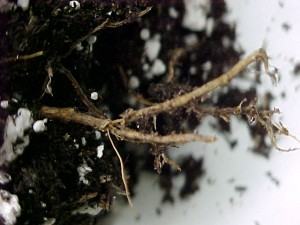Phytophthora root and stem rot
Pathogen: Phytophthora spp. (P. cactorum, P. drechsleri, P. nicotianae, etc.)
Hosts Include: Achillea, Clematis, Euphorbia, Fragaria, Heuchera, Leucanthemum, Lilium, Phlox, Platycodon, Sedum, Sempervivum, Scabiosa, and Viola.
Symptoms: Stem and crown rot, root rot, stunting, wilting, yellowing. Infection of above ground plant parts causes foliar dieback. Plants with low levels of infection may not have obvious symptoms.
Spread: Phytophthora is a soil borne pathogen, spores can also be disseminated short distances through the air. The movement of infested plant material contributes to the spread of disease. Phytophthora has several different spore types including chlamydospores, sporangia, zoospores and oospores. (Refer to Pythium root rot for a description of these spore types).
Management: Management strategies for Pythium spp. also apply to Phytophthora spp. Symptomatic plants should be removed and destroyed. Fungicides are often used to prevent losses due to Phytophthora spp. It is important to get good coverage of the plant parts being affected. Fungicides have limited scope and should not be expected to cure heavily infected plants. Systemic fungicides should be used in rotation with protectant fungicides to delay resistance development. Applications at the high end of the labeled rate are required for Phytophthora control.




 Print
Print Email
Email